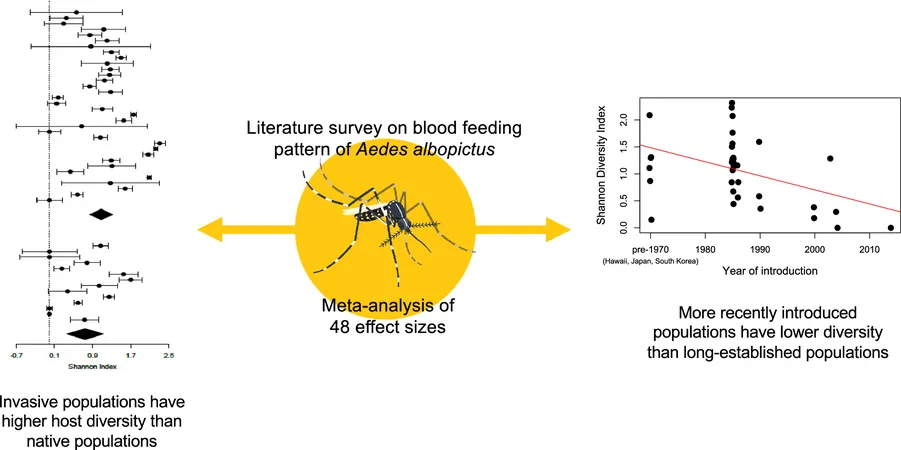
The Global Spread of Aedes albopictus: A Closer Look at its Diverse Diet and Implications for Disease Transmission
2024-10-03
Introduction
The invasive mosquito species Aedes albopictus, commonly known as the Asian tiger mosquito, has emerged as a significant threat to public health and veterinary safety worldwide. Not only is it known for its ability to travel vast distances and thrive in various habitats, but it also poses risks by transmitting severe pathogens. Understanding how this mosquito establishes ecological relationships across different regions is crucial for addressing its role in disease spread.
Research Overview
To delve into the dietary diversity of Aedes albopictus, a comprehensive meta-analysis was conducted based on various blood meal studies. This research included data from 48 distinct locations, utilizing the Shannon diversity index—an established measure of biodiversity—to assess the impacts of multiple variables such as invasion status, habitat types, survey methodologies, and the timing of the mosquito's introduction in various regions.
Key Findings
The results indicated that Aedes albopictus exhibits greater dietary diversity in its invasive ranges compared to its native areas. Crucially, older invasive populations demonstrated a broader diet than those that had been introduced more recently. This finding illustrates how established populations have refined their feeding behaviors over time, enhancing their potential as vectors for disease transmission.
For instance, while human blood is a common dietary component for these mosquitoes, particularly in urban regions, they also feed on a variety of animal hosts. Their opportunistic feeding habits make them an effective bridge for zoonotic diseases, potentially increasing transmission rates among different host species.
Ecological Flexibility and Adaptation
Aedes albopictus has showcased impressive ecological adaptability, thriving in both urban and rural environments. Originally found in Southeast Asia's forests, these mosquitoes have successfully transitioned to artificial breeding sites often found in urban settings, such as discarded tires and water containers. This adaptability not only supports their survival in varying climates but also their wide host range—culminating in complex interactions in both natural and human-dominated landscapes.
Factors Influencing Dietary Diversity
The research underscored that habitat types significantly influence feeding patterns. Urban environments typically yield lower taxonomic diversity in terms of blood meals, primarily due to the high proportion of human-derived blood. In contrast, rural habitats provide a broader spectrum of potential hosts, allowing these mosquitoes to explore a wider dietary range. Despite these habitat influences, the diversity observed in invasive populations exceeded that of native ones, suggesting an inherent flexibility and capability to exploit different ecological niches.
Implications for Disease Transmission
The findings of this research highlight the potential consequences of Aedes albopictus's dietary diversity on public health. Higher taxonomic diversity in invasive populations could lead to an increased capacity for pathogen transmission, especially in areas with a mix of domestic and wildlife hosts. This phenomenon raises urgent concerns for public health officials, especially in light of emerging vector-borne diseases.
Closing Thoughts
As the Asian tiger mosquito continues to proliferate across the globe, understanding its feeding behaviors and ecological dynamics becomes more imperative. The implications of this research signify not only the risk of disease transmission but also the need for proactive measures in mosquito control strategies. The ability of Aedes albopictus to adapt to new environments and host species calls for a thorough approach to public health policy, monitoring, and intervention to mitigate the risks associated with this formidable invasive species.
This study ultimately shines a light on the necessity of comprehensive research into invasive species and their impacts on human and animal health—an ongoing battle that requires global cooperation and action.



 Brasil (PT)
Brasil (PT)
 Canada (EN)
Canada (EN)
 Chile (ES)
Chile (ES)
 España (ES)
España (ES)
 France (FR)
France (FR)
 Hong Kong (EN)
Hong Kong (EN)
 Italia (IT)
Italia (IT)
 日本 (JA)
日本 (JA)
 Magyarország (HU)
Magyarország (HU)
 Norge (NO)
Norge (NO)
 Polska (PL)
Polska (PL)
 Schweiz (DE)
Schweiz (DE)
 Singapore (EN)
Singapore (EN)
 Sverige (SV)
Sverige (SV)
 Suomi (FI)
Suomi (FI)
 Türkiye (TR)
Türkiye (TR)